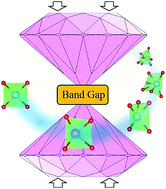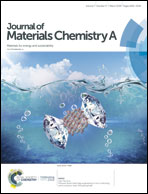Pressure-driven band gap engineering in ion-conducting semiconductor silver orthophosphate†
Abstract
The obtainment of active semiconductor photocatalysts remains a challenge for converting sunlight into clean fuels. A pressing need is to explore a novel method to tune the electronic band structures and gain insightful knowledge of the structure–property relationships. In this work, taking silver orthophosphate (Ag3PO4) as an example, a static pressure technique is applied to modulate the band gap and indirect–direct band character via altering its crystal structure and lattice parameters. Under ambient conditions, cubic Ag3PO4 possesses an indirect-band gap of ∼2.4 eV. At elevated pressure, the band gap of Ag3PO4 narrowed from 2.4 eV to 1.8 eV, reaching the optimal value for efficient solar water splitting. During the pressure-induced structural evolution from cubic to trigonal phases, the indirect-to-direct band gap crossover was predicted by first-principles calculations combined with structure search and synchrotron X-ray diffraction experiments. Strikingly, the observed band gap narrowing was partially retained after releasing pressure to ambient pressure. This work paves an alternative pathway to engineer the electronic structure of semiconductor photocatalysts and design better photo-functional materials.



 Please wait while we load your content...
Please wait while we load your content...